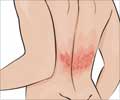An itchy sensation is caused by a chemical released by S. aureus that activates a protein on nerve fibers that transmits signals from the skin to the brain.
- Itching is a sensory reflux to scratch at the source point which occurs primarily due to inflammatory skin diseases
- A new study reveals that Staphylococcus aureus on the skin causes itching, by triggering a molecular-neural chain reaction between skin and brain //
- These findings redefine the treatment and therapeutic management of skin diseases
S. aureus drives itch and scratch-induced skin damage through a V8 protease-PAR1 axis
Go to source).
Solving the Missing Link in the Itch- Scratch Puzzle
Immune cells, such as mast cells and basophils—which are often known to cause itching and are associated with skin allergies—failed to do so after being exposed to bacteria. Neither did pro-inflammatory chemicals called interleukins or white blood cells, which are known to be triggered during allergic reactions in skin disorders including eczema and atopic dermatitis.S. aureus which is stimulated by innocuous stimuli triggers a hyperactive response, a condition called alloknesis. Alloknesis is the itchy or pruriceptive sensation evoked by a stimulus that is normally non-pruriceptive. Alloknesis is common in patients with chronic skin conditions and also in anonymous conditions like itching from a wool sweater.
The stimulated S. aureus releases a bacterial enzyme called protease V8. This V8 protease enzyme works by activating a protein called PAR1, which is present on skin neurons that come from the spinal cord and send several signals from the skin to the brain, including touch, heat, pain, and itching (2✔ ✔Trusted Source
Physiology and Pathophysiology of Itch
Go to source). This sets up a vicious cycle of itching, inflammation, and itching again.
The enzyme protease V8 was single-handedly responsible for initiating itch.
Beyond Itch-Scratch Cycle
The protein PAR1, which is triggered by S. aureus, is also connected to blood clotting.These potential findings can retransform the design of oral medicines and topical creams to treat persistent itch associated with skin conditions linked to an imbalance in the skin microbiome, such as atopic dermatitis, prurigo nodularis, and psoriasis.
References:
- S. aureus drives itch and scratch-induced skin damage through a V8 protease-PAR1 axis - (https://www.cell.com/cell/fulltext/S0092-8674(23)01164-9)
- Physiology and Pathophysiology of Itch - (https://journals.physiology.org/doi/full/10.1152/physrev.00017.2019)
Source-Medindia













